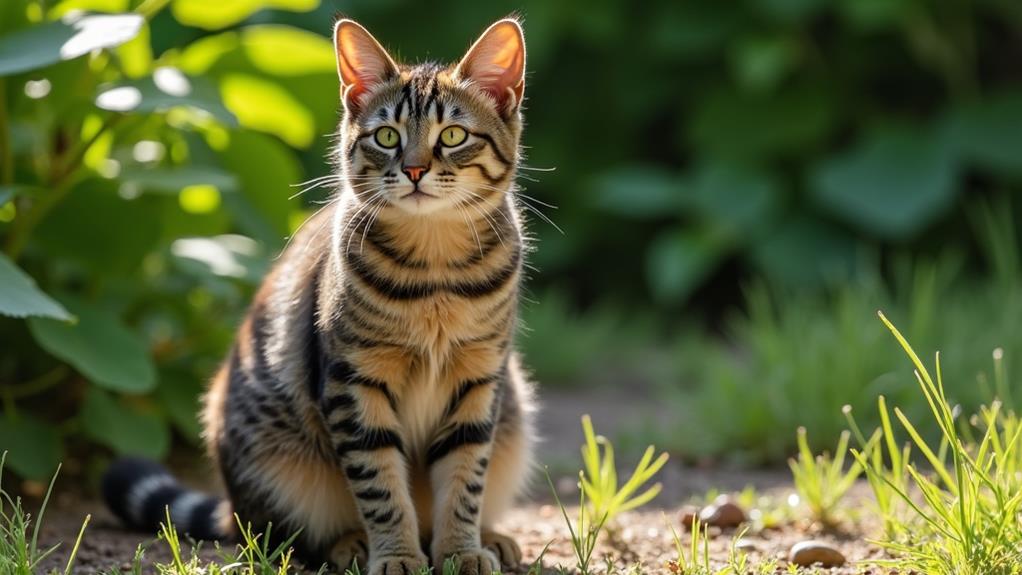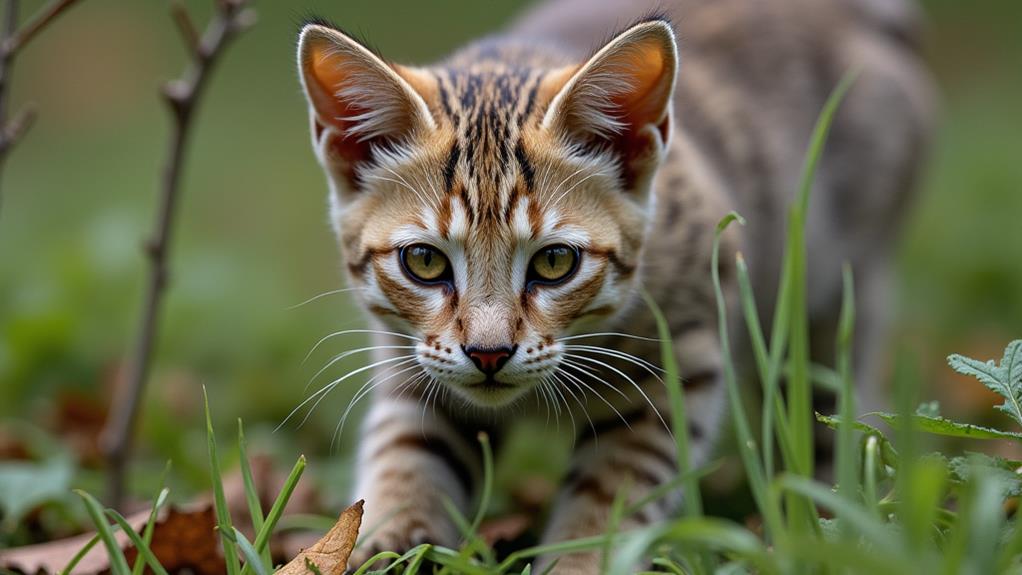How to Tell if a Cat Is Feral: Key Signs and Behaviors
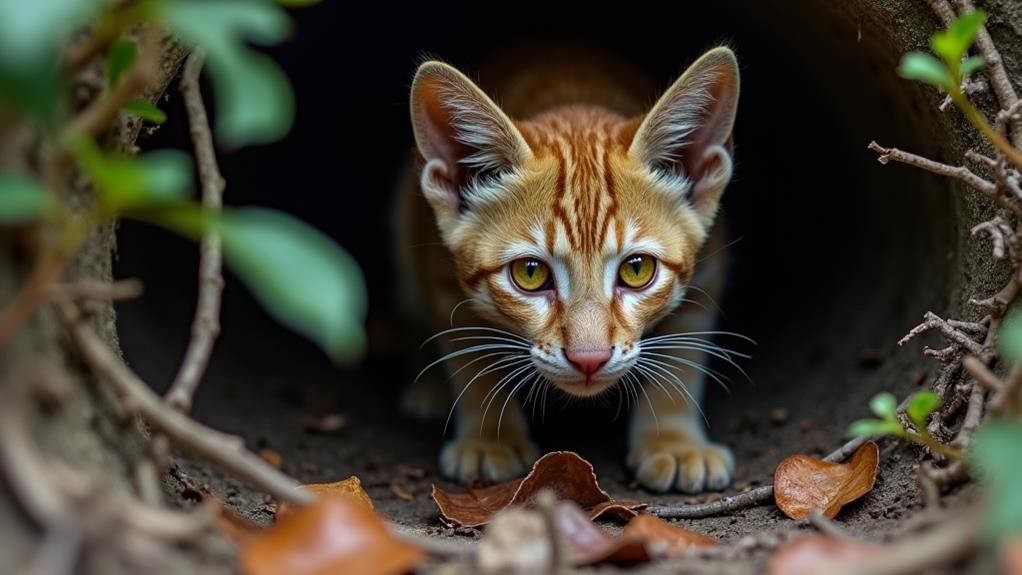
To tell if a cat is feral, look for their unsocialized behavior, scruffy appearance, and avoidance of humans. Feral cats often display defensive stances, like pinned-back ears and tucked tails, and they flee or hide when approached. They lack collars or ID and have a lean, sometimes unkempt look, due to outdoor living. Their eyes remain wide open, indicating high alertness, and they might hiss or swat if feeling threatened. Unlike strays, feral cats won't meow for attention and usually stay active at night. By understanding these behaviors and signs, you'll gain clearer insights into their nature.
Understanding Feral Cats
Feral cats, often misunderstood, are typically unsocialized and wary of human interaction. When you encounter them, their behaviors often include hiding or quickly fleeing, as they're generally born and raised in environments without much human contact. This naturally leads to their distrust of people and a strong preference for outdoor living. Unlike their more socialized counterparts, feral cats tend not to warm up to humans, making them less likely to adapt to indoor environments.
Pay attention to the body language of feral cats, as it's a key indicator of their wild nature. They often exhibit defensive postures, such as crouching low to the ground, flattening their ears, and tucking their tails tightly against their bodies. These signals suggest they're on high alert, ready to defend themselves if necessary. Furthermore, their vocalizations differ considerably from those of stray cats. Instead of friendly purrs or meows, feral cats might emit loud, guttural sounds when they feel threatened or cornered.
Understanding these behaviors and body language cues can help you distinguish feral cats from other outdoor cats, offering insight into their cautious and independent lifestyles.
Stray vs. Feral Differences
How can you tell the difference between stray and feral cats? Stray cats are usually former pets, displaying friendly behavior and a desire for human interaction. They might vocalize and approach you for food or affection. In contrast, feral cats have had little to no contact with humans and often react with avoidance or aggression. They tend to remain silent and will likely flee or hide when you come near.
When observing physical appearance, stray cats often look clean and may appear well-fed, indicating they've had recent human care. Feral cats usually have a scruffy, unkempt appearance due to their tough outdoor lifestyle. If you encounter a cat that seems approachable, check for identification like collars or microchips, common with strays.
Feral cats, however, are less likely to have identification and might show signs of having participated in Trap-Neuter-Return (TNR) programs, such as the distinctive ear-tipping. While stray cats can often be rehabilitated and readjusted to indoor living with patience, feral cats are less likely to adapt to domestic life and may remain fearful of humans, even after extended exposure. Understanding these differences can help you determine the best way to interact with and support these cats.
Behavioral Indicators
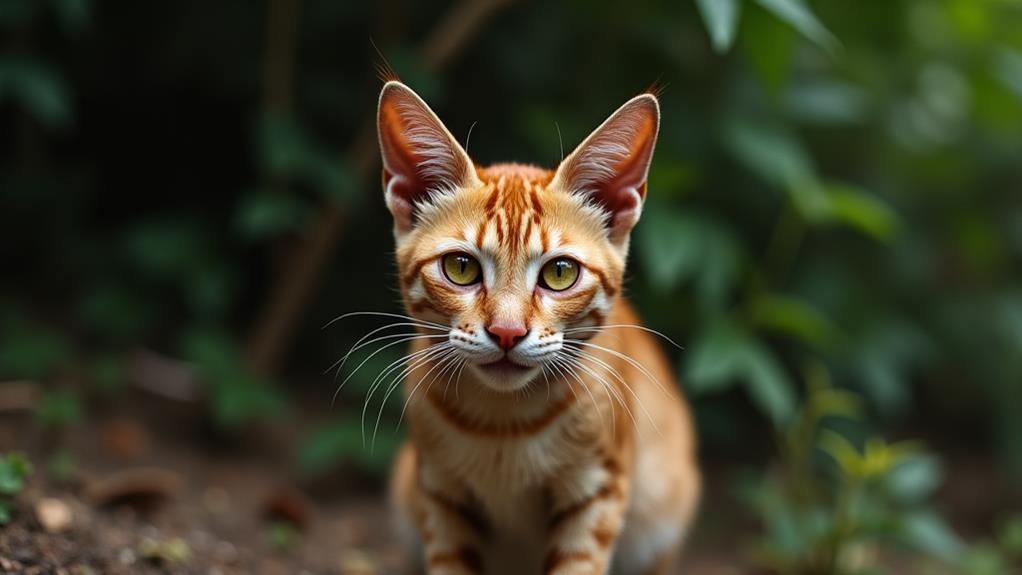
Understanding the behavioral indicators of a cat can offer valuable insights into if you're dealing with a feral feline. Feral cats tend to avoid human interaction, often fleeing or hiding when someone approaches. This behavior is a clear indicator of their distrust towards humans. You might notice these cats lack the comfort level that stray or house cats exhibit around people. They don't wear collars or identification tags, differentiating them from owned or stray cats.
Feral cats express themselves differently through their vocalizations. Instead of the friendly meows you're used to hearing, feral cats produce loud, guttural sounds, especially when they feel threatened. This defensive vocalization is another strong behavioral indicator distinguishing them from more domesticated cats. Their hunting instincts are robust and visible in behaviors like stalking and pouncing, reflecting their need to adapt and survive in the wild.
If you encounter a cat displaying these signs, it's likely a feral cat. Recognizing these behavioral indicators helps you understand their life experiences and interactions with humans. Being aware of these signs guarantees you can respond appropriately to their needs and habits.
Physical Characteristics
When you're trying to identify a feral cat, their physical characteristics can provide significant clues. Feral cats often sport a scruffy or unkempt appearance due to their outdoor lifestyle. Their fur may be matted and neglected, showing signs of wear and tear from exposure to the elements. Unlike stray or owned cats, feral cats typically don't have collars or any form of identification, making it easier to distinguish them from those who might have tags or other identifiers.
Their body condition can also offer insights. Feral cats are usually lean or even malnourished, as they depend on hunting and scavenging for their meals. This lifestyle contrasts starkly with well-fed house cats or stray cats who may have more access to regular feeding. Furthermore, you'll notice their eyes often appear more alert and wide-open. This heightened state of awareness reflects their readiness to flee from potential threats, a necessary adaptation for survival in the wild.
Socialization Levels
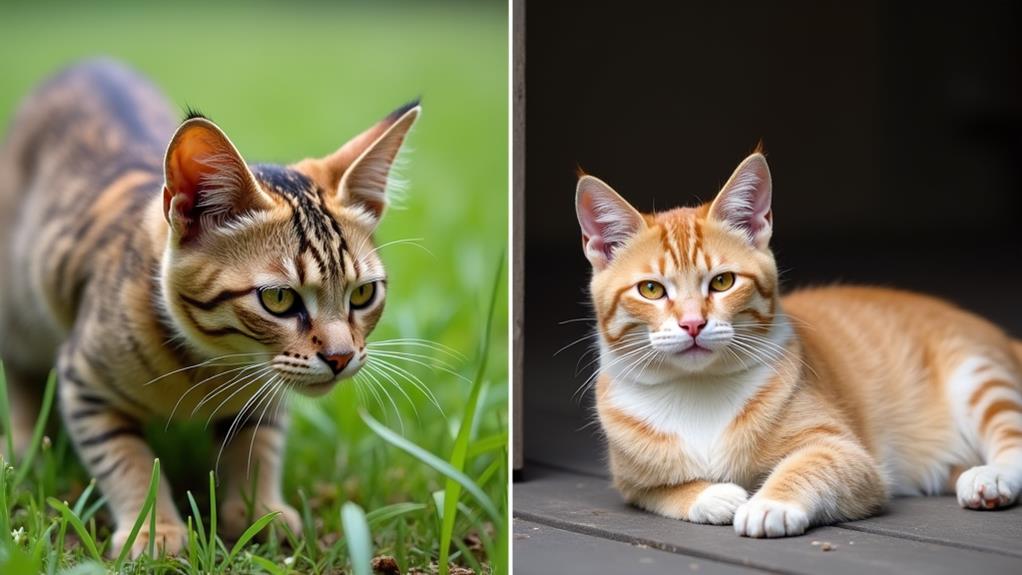
While physical traits offer clues about a cat's lifestyle, their behavior reveals even more about their socialization levels. Socialization levels in cats vary greatly, ranging from friendly strays to elusive feral cats. Understanding these behaviors is essential for determining the right approach to care for each type of cat. Stray cats often seek human interaction, showing signs of friendliness and curiosity. They might approach you, meow, or even rub against your legs. In contrast, feral cats tend to avoid human contact and might hide, flee, or exhibit defensive body language when approached.
Here are three key behaviors to help identify a cat's socialization level:
- Approachability: Stray cats might come toward you willingly, whereas feral cats will likely keep their distance or run away.
- Vocalization: Strays often use vocal cues, like meowing, to communicate, while feral cats rely more on silent body language to express fear or discomfort.
- Adaptability: Kittens under four months are more adaptable and can be socialized more easily than adult feral cats.
Recognizing these differences helps in determining suitable care strategies, such as adoption for socialized strays or TNR (Trap-Neuter-Return) programs for feral populations.
Observational Tips
Perceptiveness plays a crucial role in identifying if a cat is feral, and observing from a safe distance guarantees you don't cause unnecessary stress. Take note of how feral cats react to your presence. If they exhibit avoidance, such as fleeing or hiding, it indicates a lack of socialization with humans. This skittish behavior is a key sign that you're dealing with a feral cat rather than a stray or a tame one.
Pay close attention to their body language. Signs like crouching low, flattened ears, and a tucked tail are clear indicators that the cat is distressed and fearful of human interaction. These physical cues can give you valuable insights into their comfort levels and their potential for domestication, or lack thereof.
Observing their feeding habits can also offer clues. Feral cats often rely on scavenging and display strong hunting instincts. These behaviors highlight their survival skills in the wild, setting them apart from domesticated cats. Consistent avoidance of interaction and defensive vocalizations further suggest that the cat has little potential for adapting to a domestic environment. By understanding these behaviors, you can better assess the cat's feral nature without direct interference.
Approaching With Caution
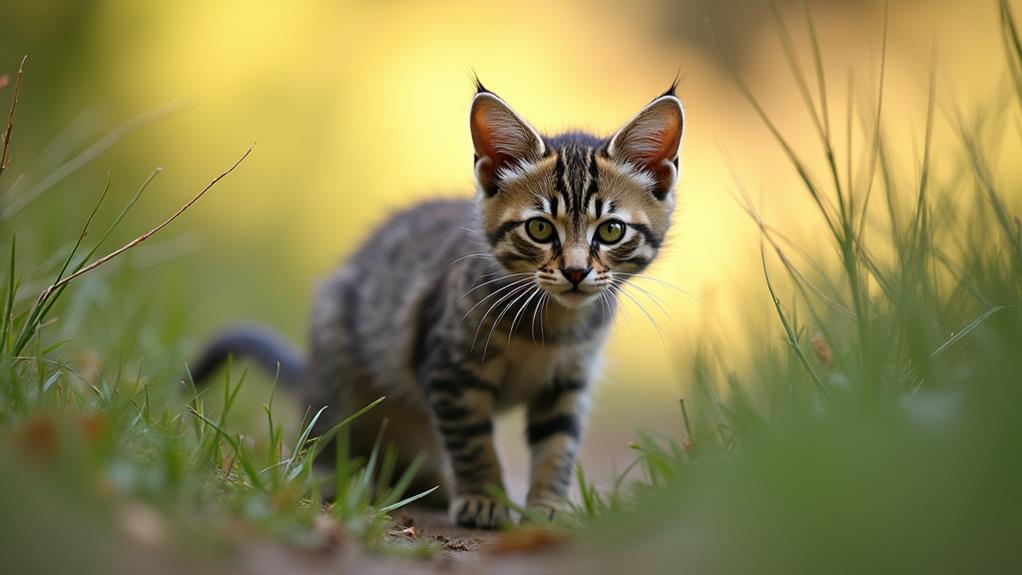
Before approaching a suspected feral cat, maintain a respectful distance to guarantee you don't startle it. Feral cats are naturally wary of humans, and sudden movements or loud noises can easily provoke a flight or fight response. Your approach time should be slow and deliberate, allowing the cat to assess your intentions from afar.
- Observe the Cat's Body Language: Look for signs of fear or aggression. Crouching, flattened ears, or a tucked tail signal discomfort. If you notice these, pause your approach and give the cat space.
- Offer Food at a Distance: Place food nearby and step back. This allows the cat to associate your presence with a positive experience without feeling threatened. Over time, this can help build trust.
- Let the Cat Dictate the Interaction: Allow the cat to come to you on its own terms. Forcing interaction only heightens fear and avoidance. Patience is key in gaining the trust of a feral cat.
If the cat displays aggression or extreme fear, it's wise to retreat. Consider seeking help from local animal welfare organizations, as they have experience in safely handling feral cats.
Supporting Feral Colonies
Supporting feral colonies requires a concerted effort to provide consistent feeding stations that offer nutritious food and clean water. This reliable resource not only helps sustain feral cats but also makes their lives a bit more stable. It's essential to implement Trap-Neuter-Return (TNR) programs as a part of your strategy. TNR helps control the population by reducing unwanted litters and fosters a healthier, more stable colony.
Besides feeding and neutering, you should monitor the health of the feral cats. Look for signs of illness or injury. If you notice anything concerning, don't hesitate to reach out to local animal welfare organizations for help. Providing shelter is another significant aspect of supporting feral colonies. DIY insulated boxes can protect cats from harsh weather, increasing their survival chances and general well-being.
Lastly, engage with your community. Raising awareness about feral cat welfare and the benefits of TNR can garner more support for managing colonies. It can also help reduce any stigma these animals might face. By doing so, you not only support the colonies but also foster a more compassionate community spirit.
TNR Programs Benefits

Engaging with your community is a great way to amplify the benefits of Trap-Neuter-Return (TNR) programs. These initiatives play a vital role in managing feral cat populations and promoting animal welfare. By participating in TNR programs, you not only help prevent the birth of unwanted litters but also contribute to healthier feral cat communities. Neutering reduces the risk of diseases and injuries, which are often linked to mating and territorial fights.
Consider these three benefits of TNR programs:
- Population Control: TNR programs effectively reduce feral cat populations by ensuring that fewer kittens are born, creating a more stable and manageable community of cats.
- Ecosystem Stability: With fewer feral cats, there's less impact on local wildlife. This means reduced predation on birds and small mammals, allowing ecosystems to thrive.
- Community Education: Involvement in TNR initiatives raises awareness about responsible pet ownership. It encourages more people to spay and neuter their pets, reducing future stray populations.

